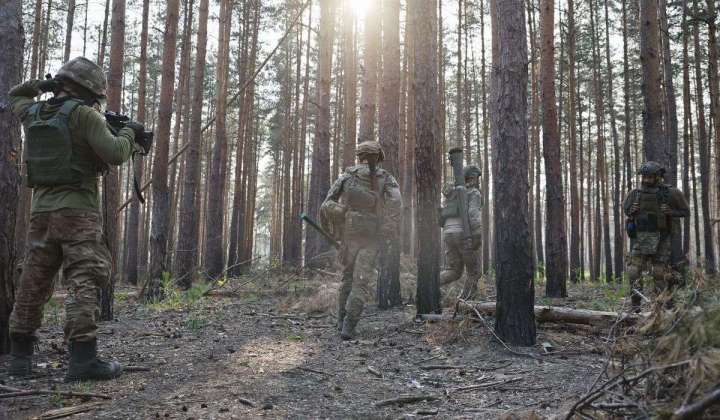Both sides seek high ground in PR wars as Ukraine offensive kicks off

It didn’t take long for the fog of war to settle over Ukraine’s long-awaited spring counteroffensive, with both sides claiming to see bright spots in the fighting Sunday in a clash that could determine the fate of Russia’s 16-month invasion.
Ukrainian President Volodymyr Zelenskyy all but confirmed the attack was underway over the weekend during a visit to Kyiv by Canadian Prime Minister Justin Trudeau. Private Western military analysts say reports on the ground and from satellite imagery say Ukrainian forces have begun advances in at least four sectors along a 600-mile front against dug-in Russian troops in occupied eastern and southern Ukraine.
Ukrainian leaders say the initial results have been positive, claiming Sunday that at least three villages in the western Donetsk region once held by Russia and its local separatist allies have now been retaken.
“I am in touch with our commanders. Everyone is positive,” Mr. Zelenskyy said Saturday evening, while saying he could not talk in detail about the fighting.
But the Kremlin — as well as Russian military bloggers who have in the past been harshly critical of the Russian strategy and performance in the field — said Ukrainian gains to date had been negligible and Russian defensive lines have generally held so far.
The Washington-based Institute for the Study of War, which has closely tracked the fighting since Russian President Vladimir Putin authorized the invasion in February 2022, cited one Russian military blogger who said the defensive operations in southern Ukraine “are relying on three main components: early detection and destruction of Ukrainian assault formations, massive use of anti-tank weapons, and mining of territories near Russian defensive positions.”
SEE ALSO: Biden, British PM say they will support Ukraine for as long as it takes
Ukrainian armored vehicles, many of the Western-supplied, have been hit as they try to negotiate new minefields laid down by Russian defenders, and are vulnerable again when they try to pull back, the blogger claimed.
Russia’s Defense Ministry on Sunday claimed that Ukrainian attacks in at least two points in the east and south had been “unsuccessful.”
The stakes are extraordinarily high: If Ukraine can build on its successes in late 2022 with the new offensive, Russian-held territory would be split in half and Russia-annexed Crimea cut off.
If Russian forces can hold in the coming months, the Zelenskyy government faces a longer war of attrition against a larger and more populous adversary that could force Kyiv to sue for a partial peace.
The BBC reported that fighting has escalated in the southern region of Zaporizhzhya, long considered a likely line of attack as Ukraine seeks to recover access to the Sea of Azov. Both sides are struggling to determine how the breach of a major dam on the Dnieper River separating Ukrainian and Russian forces in the Kherson region will affect the fighting.
U.S. Defense Secretary Lloyd Austin and other NATO defense ministers are likely to get a more detailed update when they gather for a two-day summit in Brussels starting Thursday. President Biden and other NATO leaders will come together early next month in Lithuania for a highly-anticipated summit.
Western military analysts say both sides have cause for both optimism and concern as the counteroffensive gains momentum in the coming days. Unlike the early days of the war, Russia now has the advantage of playing defense, and has used the winter months to build up a formidable array of barriers, mines and other obstacles to slow down the Ukrainian forces.
“To shift the offense-defense balance in its favor, Russia has designed one of the largest defensive systems in Europe since World War II,” Seth G. Jones, Alexander Palmer and Joseph S. Bermudez Jr. wrote in an analysis of the fighting Friday for the Center for Strategic and International Studies.
But in a war that has repeatedly defied predictions, the CSIS writers caution that Russia has its own vulnerabilities and that resourceful, motivated attackers have historically overcome even the most formidable defense barriers.
“Fortifications are only as good as the forces defending them,” they write, adding that Russia must hold back incursions along a 600-mile front.
For their part, Ukraine’s military is attempting an “extraordinarily difficult tactical operation,” according to the Institute for the Study of War analysis — “a frontal assault against prepared defensive positions, further complicated by a lack of air superiority.”
But Ukrainian forces have been bolstered by a steady stream of weaponry and technology from the U.S. and its allies. Russian military bloggers concede that Ukraine has an advantage in night-fighting because of night-vision goggles supplied by the West.
There was also fresh evidence Sunday that Mr. Putin’s government has yet to settle internal feuding that has hampered the invasion from the start.
Yevgeny Prigozhin, the outspoken head of the Wagner Group mercenary force, reportedly has rejected a new move by Defense Minister Sergei Shoigu to put his fighters under direct government control.
Mr. Shoigu has ordered all “volunteer detachments” to sign contracts and register with the ministry, but Mr. Prigozhin has declared “Wagner will not sign any contracts with Shoigu.”
And several analysts noted that the modest achievements to date by Kyiv have come with the bulk of the massive Ukrainian attacking force built up in the recent months still not having entered the battle.
In an interview with Ukraine-based Radio NV, military strategist Oleksiy Hetman said, “What is happening now could be called ‘reconnaissance in battle’ — the first stage of the offensive.” Quick and deep advances into Russian-held areas in the first days of the fighting, he said, were not realistic.
“The goal was to check the enemy’s defenses. Let’s wait a few days and see.”
— This article was based in part on wire-service reports.






